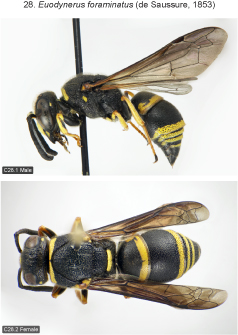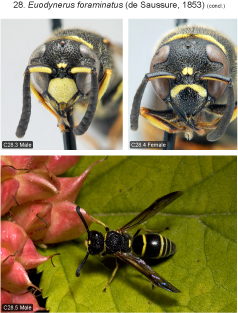
| Home | Table of contents | Keys | Species list | Glossary | Image data | PDF | Cite this article | Feedback | Updates |
Identification Atlas of the Vespidae (Hymenoptera, Aculeata) of the northeastern Nearctic region
CJAI 05, February 19, 2008
doi: 10.3752/cjai.2008.05
Matthias Buck, Stephen A. Marshall, and David K.B. Cheung
Department of Environmental Biology, University of Guelph, Guelph, Ontario, Canada N1G 2W1
Next species | Previous species | Key
28. Euodynerus foraminatus (de Saussure, 1853)
Figs B2.24, 44; B5.12, 14, 42, 51; C28.1–5.

|

|
Species recognition. This species is most similar to Euodynerus sp. F, E. blakeanus and the rare yellow form of E. leucomelas, from which it can be separated by the characters mentioned in the key. Euodynerus boscii is also similar but has conspicuous long hair (hair length over 1.5x mid ocellar diameter) on all metasomal terga (shorter and much sparser in E. foraminatus), posterolaterally subangulate tegulae (perfectly rounded in E. foraminatus-group), and lacks long hair on the ventral surface of the male fore femur.
Variation. Fore wing length 6–9 mm (♂♂), 7–10.5 mm (♀♀). The punctation of the apical fasciate part of tergum 2 and following terga varies from moderately to coarsely punctate. In coarsely punctate specimens the apical margin of tergum 2 is more or less reflexed, lamellate and translucent. Female clypeus usually with arcuate yellow dorsal spot, sometimes narrowly to broadly divided, exceptionally all black. Female mesopleuron usually with large yellow dorsal spot, sometimes small, rarely missing; male mesopleuron often black, sometimes with small yellow dorsal spot. Female occasionally with a pair of small yellow spots on scutellum. Tegula with yellow anteriorly and posteriorly, the yellow areas more reduced in male but rarely absent. Parategula yellow, in male often only tip and then sometimes more amber, very rarely completely black. Propodeum very rarely with yellow spots on dorsal surface and on ventral half of lateral ridge. Metasomal terga 1–4 always fasciate, in female sometimes also tergum 5 medially, in male usually tergum 5 and sometimes middle of 6. Female sterna 2–4 with posteroapical yellow spots, rarely absent on 4; male sternum 2 usually with apical fascia, rarely reduced to lateral spots, sterna 3, 4, usually 5 and often 6 with posterolateral yellow spots, rarely one or more with more or less developed apical fascia; male sternum 2 rarely with a pair of discal yellow spots.
One aberrant female from Killbear Provincial Park, Ontario has yellowish ivory markings. The pale markings are very extensive and include a pair of large ivory spots on the dorsal surface of the propodeum, a complete apical fascia to tergum 5, and a broadly interrupted apical fascia to sternum 2. The specimen is recognisable as E. foraminatus based on the slightly thickened hind margin of tergum 2 and the relatively strong punctation of preapical areas of terga 2–4.
Distribution. Canada: all provinces. U.S.: transcontinental (Krombein 1979). Mexico: Tamaulipas (Rodríguez-Palafox 1996). Probably all of the currently recognised subspecies of E. foraminatus (see Krombein 1979) represent different species. Euodynerus foraminatus is the most common species of the genus in most of the eastern Nearctic region, except at northern localities.
Biology. Nests in borings in wood, hollow twigs, and other suitable cavities like old Polistes cells, corrugated cardboard, etc. Uses mud or firmly agglutinated sand for cell partitions and closing plugs. Prey are caterpillars of Oecophoridae, Tortricidae, Gelechiidae, Pyralidae, Crambidae (Pyraustinae) and Thyrididae (Krombein 1967, 1979).
Next species | Previous species | Key
| Home | Table of contents | Keys | Species list | Glossary | Image data | PDF | Cite this article | Feedback | Updates |
